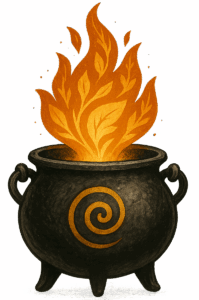Samhain is the pagan start of the new year, the threshold at year’s end, the place where grief and gratitude hold hands. Folklore says the boundary thins, and whether we read that literally or as a poetic truth, most of us feel the tilt. Fires were kindled; mumming and divination games appeared; protective charms guarded doors and animals. More than anything, this was ancestor time: names spoken, plates set, stories kept alive.
Historically, communities marked transitions at Samhain. This is when cattle were brought in from pasture, rents settled, it’s the practical year reset. Harshness and humor danced together in old customs, which is exactly how loss often works. The ethical thread is simple: remember well, protect the living, and carry the good forward.
In modern druidry I keep Samhain consent-forward and tender. Set a place at the table with a photo or token and eat a few quiet bites in their honor. Light a small candle and say a name you carry with love. If family of origin is complicated, choose ancestors of spirit like teachers, friends, artists… the ones who helped you become you. Write down what you’re ready to compost and let it go in fire or soil.
Symbols here are deliberate: a candle in the window for safe passage, salt for keeping, black cloth for the mystery we don’t rush to solve. Southern hemisphere folks will meet this work in May. Wherever you stand, Samhain asks for courage, protection, and the faithful keeping of stories.
